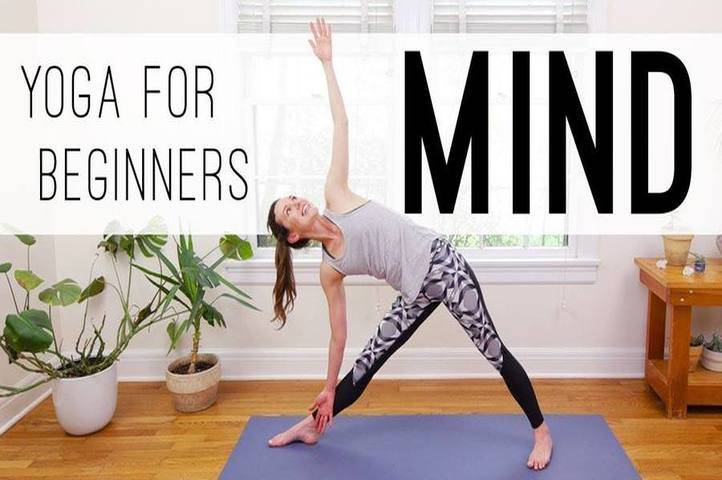
by Tirtha Acharya | Jul 7, 2019 | Yoga
Practicing yoga has multiple benefits for the mind, spirit, and body. Yoga Asanas can control aging, lift our disposition and help in curing disease. Moreover, yoga is a practice that anyone can get into no matter what background. This article will look at the basic Yoga Asanas for beginners, and how each of them can benefit your health.

1. Bitilasana
Bitilasana means the cow pose. It’s an easy, gentle technique to warm up the spine. You start on your hands and knees with the Bharmanasana (table top) pose. Ensure that your wrists, elbows, and shoulders are aligned and perpendicular to the floor. Also, keep your knees directly below your hips. As you inhale lift your head and chest towards the ceiling while allowing your belly to sink to the floor. As you do the pose, remember to protect your neck by drawing your shoulders down and away from your ears. When you exhale, come back to the Bharmanasana. This pose helps in stretching the neck and front torso. It also provides a gentle massage to the spine and organs in the belly region. You can pair this with the Marjaryasana (cat pose).

2. Adho Mukha Svanasana
This is more commonly known as downward-facing dog. It’s arguably the most popular yoga pose, also because of its all-over rejuvenating stretch. To do the pose, start with Bharmanasana. Remember to plant your hands and spread your palms. Then, exhale deeply while you lift your knees away from the floor. Lengthen your tailbone away from your pelvis. Push your thighs back and plant your heels onto the floor. Straighten your knees but be mindful not to lock them. Take a few breaths here. This asana has many benefits: it energizes the body, improves digestion and calms down the brain. It also prevents osteoporosis and relieves headaches and insomnia.
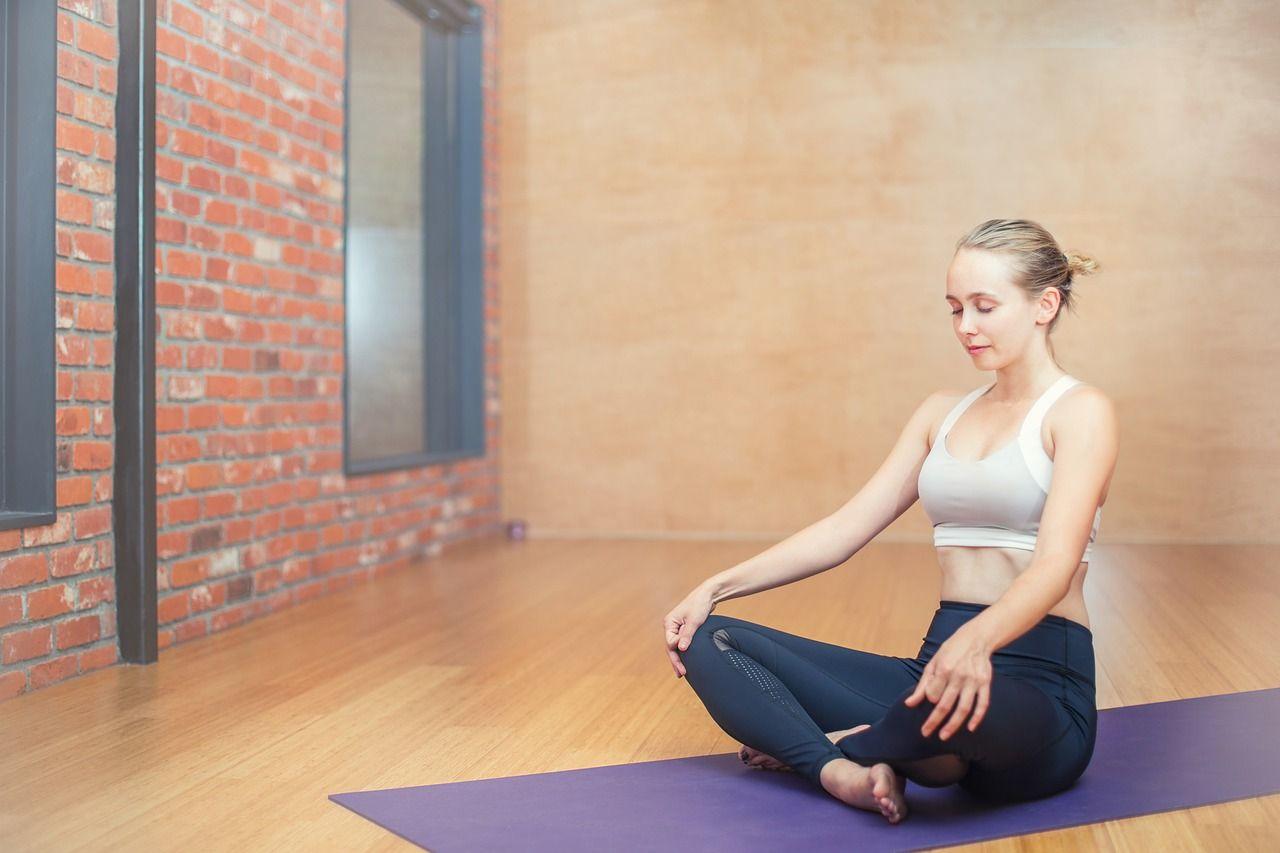
3. Sukhasana
Sukhasana is a leg fold that’s also called the easy pose. Start in a seated position on the floor with your legs outstretched. Then, bend your knees and fold your legs in towards your torso. Slip each foot beneath the opposite knee. Remember to relax your feet so that the outer edges rest easy on the floor. You can either place your hands on your lap or knees. This pose helps in calming the brain. It also supports the strengthening of the back, while stretching the knees and ankles.

4. Savasana
Also called the corpse pose, this asana involves total relaxation and neutrality. It involves lying down on the floor with your hands and feet stretched outward. You shouldn’t be feeling any tension during this asana. Savasana helps in quieting the mind and body. It calms the brain as well, relieving it of stress and fatigue. It also aids in lowering blood pressure.
Why You Should Take Up Yoga
The benefits of taking up yoga increase as you continually practice it. A good example of this is how professional sports stars use yoga as a way to keep their career going for longer. Times of India looked at how Canadian Olympic football player Kara Lang used yoga to help prevent injuries and improve her breathing. This allowed her to become one of the youngest members of the women’s national team.
At the other end of the age scale, Roger Federer revealed that he also uses yoga for back pain and recovery. His training has led him to be the most successful tennis player in the sport’s history. Federer is also the highest paid athlete in tennis and is one of the sport’s longest playing stars. This is due to him staying almost injury free through supportive practices like yoga. Indeed, yoga is a practice that benefits both beginners and elite athletes. It doesn’t matter if you’re in your early years or later years, now is the time to start, and these poses will help you on your journey.
The article was written for nepalyogahome.com
By: Clara Kaye
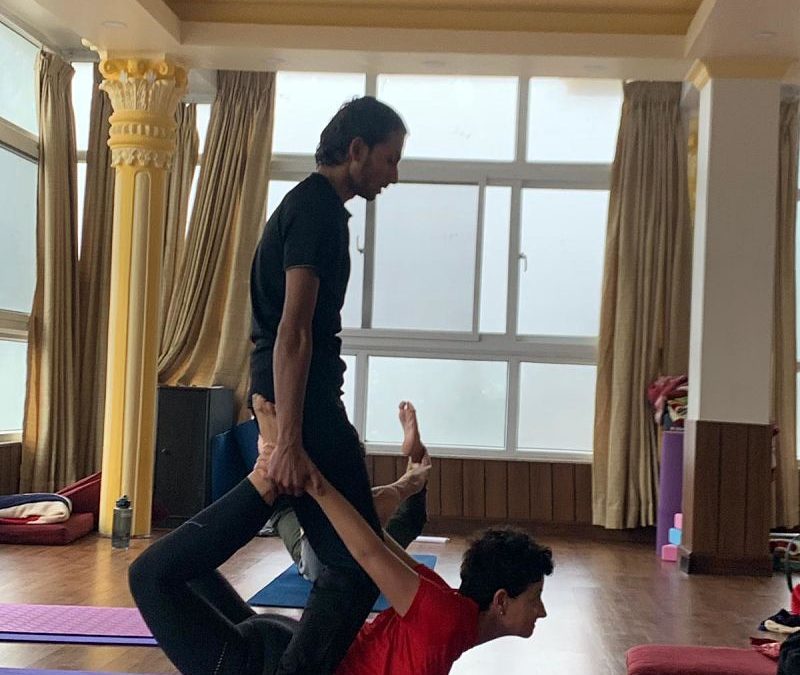
by Tirtha Acharya | Feb 8, 2019 | Ayurveda, Yoga
The meaning of yoga is to unify the body, mind, and soul to discover a balanced, harmonious and happy life where there is no sickness and bondage. So yoga fundamentally concentrates for a healthy body. Ayurveda is a sister science of yoga as both of them has the same origin i.e. Vedas.
Yoga and Ayurveda have healing effects on the body, which is their primary function. Unless the body is healthy, one cannot enjoy the real happiness and real meaning of life. First of all Yoga and Ayurveda makes your body healthy and then they lead towards a higher goal.
Healing Effects of Yoga
The limbs of yoga like Asana, pranayama, mudra, bandha, detoxification etc. all are directly connected to healing the body. Regular practice of Asana improves flexibility, balance, and strength as well as cures many ailments. The pranayama or breathing techniques gives positive effects on depression, asthma, pain, memory power, etc.
Yoga, with the proper connection of aerobic exercise, meditation, and ayurvedic diet help cardiovascular disease, blood pressure and overall systems of human beings. Yoga helps to cope in a better way with daily demands and sound sleep.
There are various researches that yoga acts as anti-aging effects promotes immunity and has healing effects for various physical and mental diseases. Some of them are as follows:
· Blood Sugar
· Blood Pressure
· Heart Diseases
· Stress
· Depression
· Cancer
· Menopause
“Psychology Today” gives the report,-“Yoga has the antagonistic consequence to suffering or pain on the brain than chronic pain.” Yoga Therapy slackens nervous system tension, chronic pain, headaches and migraines, chronic fatigue, disc problems, carpal tunnel, neck pain, glandular disorder, and many others.
There are many Western Medical institutes that have done researches and studies on health effects of yoga and Ayurveda. Timothy McCall, MD has prepared a summary of various professional medical studies named “38 Ways Yoga Keeps You Fit” which proves Yoga is the best way to cure multiple diseases like cholesterol, back pain, depression, blood pressure and circulation, abdominal diseases and much, much more.
National Geography by Ohio State University reported on a study that “Cancer patients who practiced yoga for treatment were comparatively better than those who didn’t. The rate of Inflammation controlled was much better due to the effects of yoga.
Yoga is not merely physical but has a direct relation with mind creating balance in emotions and thoughts and uplifting consciousness. In fact, more than 90% of the diseases start in the mind and affect the physical body. Yoga practice eliminates the root of suffering and leaves no place to remain diseases.
Healing Effects of Ayurveda
Yoga applies yogic techniques to heal the diseases and provide the best health while Ayurveda uses different types of plants and herbs for healing the diseases and giving the ultimate natural health since they both have the same origin and similar goal.
One of the verses from the Yoga Sutra, “yogas chitta vritti nirodhaha”, betells yoga as the harmoniously settled state of the mind and thoughts which is the perfect state of mental health. There is a verse in ayurvedic texts, svasmin dishati iti svasthah, which means that one who perennially abides coalesced with the Self is a healthy person. These verses reveal that both yoga and Ayurveda focus on the perfect health- physically, mentally and spiritually.
We can understand that Ayurveda and health have healing effects in many ways. There are other many verses in the ayurvedic texts which focus to this self-mentioned state of the mind as the essence of health. A verse from the Sushruta Samhita states, “A person is said to be a healthy person whose doshas are in balance, whose appetite is fine, whose dhatus are working properly, whose malas are harmonized and whose Self, mind and senses remain full of bliss.
Unity of Mind, Body, and Consciousness
Yoga, a Sanskrit word, means “unification” or “to connect together”. It is the yoking together to unite body, mind, and soul. Yoga makes the mind stronger by joining the mind with the Self, the Atma. The mind cannot be properly connected with the self if there are diseases or defilements in the body and mind. So, primarily yoga must have healing effects in the body.
The aim of Maharishi Ayurveda is also to experience this unity making the body healthy. The word ayurveda is a Sanskrit word which is derived from “ayu” which means “life” or “lifespan.” Therefore Ayurveda is “the science and process of life and longevity.” Another meaning of ‘ayu’ is described in Charaka Samhita (an ancient ayurvedic text)
— sharirendriya sattvatma sanyogo. . . ayu. The verse states ayu as the integrated state of body, mind, sense, and soul. Thus both yoga and Ayurveda have common goal i.e. complete unification body, mind, and consciousness. To get the unity, the fundamental element is perfect health. Thus, basically, yoga and Ayurveda works for healing.
Yoga is the complement of Ayurveda for healing
Yoga is an inseparable part of Ayurveda. It is mentioned in ayurvedic texts like the Charaka Samhita. Since Ayurveda has healing effects, nowadays many ayurvedic hospitals are opened. Yoga is always in Ayurvedic hospitals for better healing effects. Yoga asana is important for dissolving physical stress, healing the body and calming the mind before meditation and focus at healthy lifestyle (dinacharya) the ayurvedic routine.
Yoga is the ideal ayurvedic exercise, because it enhances immunity power, rejuvenates the body, improves circulation and digestion, removes stress and in this way it heals the body.
Yoga has healing effects which balance all three doshas of an individual. Different yoga poses have different healing effects. For instance, forward bending poses cool Pitta Dosha. Twisting yoga asanas are good for Kapha because they promote digestion. Backward bending poses are warming and heating which balances Vata Dosha.
Yoga is always referred to as long as an individual has the strength to practice it. Yoga asanas tone all the parts of the body and purify the internal organs of toxins, which is one of the aims of Ayurveda.
Ayurveda is the complement of Yoga for healing
Yoga practitioners can get benefits from the ayurvedic activities along with yoga. For example, abhyanga (ayurvedic massage) removes toxins from the body, reenergizes the body and relaxes the muscles for yoga practice. Maharishi Ayurveda gives wide support for the better practice of yoga.
There must be a strong foundation of ayurvedic knowledge or hatha yoga runs the risk of becoming mere physical exercise. Yoga aims to purify the nadis (channels) with different postures. But for the cleansing process, only yoga is not sufficient. Ayurvedic principles have vital importance for removing ama (digestive impurities). So it is always recommended ayurvedic principles with yoga asanas by traditional yoga schools as they are too much interdependent to each other.
Along with this, the yoga practitioner needs to understand the way of detoxifying through lifestyle and dietary which will stop the accumulation of toxin in the body rather it keeps cleansing. With this purification, yoga, and Ayurveda give healing effects together.

by Tirtha Acharya | Dec 22, 2018 | Yoga
As per Vedantic philosophy, there is five dimension of life types of Koshas in the human body:- Annamaya Kosha, Pranamaya Kosha, Manomaya Kosha, Vijnanamaya Kosha, and Anandamaya Kosha.
1) Annamaya Kosha
Annamaya kosha of Human body represents the physical body that is solid or gross which is connected with Sthula Sharir. A person who is living in this layer recognizes himself as the mass of skin, bones, muscles, fat, and filth, whereas only a wise know the reality as it is, the true self, as separate from the body. It is formed with the food we take. In order to keep the annamaya kosha healthier, we give attention on a balanced diet, nutrition, and swatik food. So this is also called as the food body or the food sheath. The crops grown without the use of pesticides is also very important as people have been suffering from different problems due to harmful chemicals in food. This body requires proper exercise and rest for physical fitness. So people practice different types of exercises, yoga-asana (postures) for normal health. If the first body is pure and lighter, then it is easier to enter in the second one, pranamaya kosha. Proper fasting is also good to purify the Annamaya Kosha. One should also learn to witness the annamaya kosha during the fasting or it will not be effective.
2) Pranamaya Kosha
The next layer of the body after annamaya kosha of human body is pranamaya kosha. It is the vital force i.e. pranic force which drives both the physical and the mental activities. It is an energetic sheath and keeps radiating. Pranamaya Kosha is life force energy like electricity that gives heat and power to continue the life since it is the Kosha consisting living energy. Pranayama, chakra suddhi, Kundalini and Kriya etc are necessary to deal with pranayama kosha. The food has some effects on Pranamaya Kosha, so it requires the food earned with right action, with honest and just action. The food intake earned through dishonesty affects the pranic force as well as it causes different diseases in the physical body as well. A longer breath is the best diet for Pranamaya Kosha. One of the spiritual masters suggests taking 108 long breaths (before sunrise) between 3:30 and 5:30 am. Due to it, one becomes aware of the breath throughout the day which leads to longer breath.
The pranamaya kosha of human body gives you more freedom, newer spaces. It is not limited to the physical body, but bigger than the physical body, the annamaya kosha. It is inside the annamaya kosha and outside the annamaya kosha, which is enclosed by a subtle climate, known as aura.
3) Manomaya Kosha
Manomaya kosha of human body is also called as mind-sheath, the layer after the Pranamaya Kosha. The manomaya sheath consists of mind and manipulates the senses in mind acquired through sense organs. It is the dimension of thoughts and mental awareness. This layer is composed of mind(manas) and intellect (Buddhi). The mind is thoughtful; several thoughts arise in mind throughout the day. The mind-sheath is more approximate to the personhood than the previous two koshas. Manomaya kopsha is the cause of diversification of I, me, and mine. It carries the sanskaras. The bondage is caused due to sanskara which is at mind. This the cause of bondage and liberation is the mind. To manage the mind or thinking pattern; the intellect and awareness play a vital role. To balance manomaya kosha mantra, pratyahara, Yantra , dharana, concentration, etc are practiced.
4) Vijyanamaya Kosha
After the layer of manomaya kosha of human body, there lies an insight sheath called vijyanamaya kosha. This kosha is related to knowledge, thus it is also referred to as wisdom sheath. ‘Jnana’ means wisdom. The ability to discriminate right from wrong, virtue from vice is the function of this layer. It is an intellect body which receives information and knowledge from an outside source as well. The activity of this vijyanamaya kosha gives the ability to ask who am I, how can I help humanity? The prefix ‘Vi’ signifies the intensity. It approaches the real source of wisdom which is hidden within us; to which we were unaware. As we start being aware or it, it becomes easier to transcend this kosha.
5) Anandamaya Kosha
After the realization Vijnanamaya kosha, we move ahead to the next layer into the experience of anandamaya kosha. It is the realm of bliss, rapture etc. which consist of an unalloyed joy. It is the sheath consisting bliss. So, it is called the bliss body or the bliss sheath as well. Anandamaya kosha is the true state of ananda, connected to the deepest source. Only after experiencing Samadhi we can feel Anandamaya Kosha.
There are two types of joy- ephemeral and eternal. On the fulfillment of our desires and favorable situations, we acquire ephemeral or transitory joy while eternal joy is unconditional which is experienced after reaching anandamaya kosha.
Vedantic philosophy states that a wise person becomes mindful on the subtle influence of the five elements within each kosha, perennially cognize the self.
One of the interesting facts is that every physical cell has pancha kosha. Annamaya Kosha is connected with sthula sharir (physical body). Next three kosha- pranamaya, manomaya and vigyanamaya koshas are linked with shukshma sharir (astral body). The fifth sheath, anandamaya kosha is related with karan sharir (causal body).
There is an important series of yogic practice to deal with all pancha kosha. Yoga asana (postures) with adequate holding is practiced for the exercise of annamaya kosha. During the holding, awareness of breath is practiced focusing particular point. At this time, long breath with ujjayai sound can also be practiced to bring the mind in concentration. It is the part of pranayama to deal with pranayama kosha. The same sequence can be practiced again bringing deeper feeling and sensations on the body in each posture which deals with manomaya kosha of human body. The body gets tired after the practice of asana (postures), so savasana (corpse pose) or yog nindra (yogic sleep) is practiced after the completion of asana practice. This relaxation helps to communicate to vigyanamaya kosha. Finally, the time is for meditation after savasana. Meditation is only the way to enter in the realm of anandamaya kosha.
by Tirtha Acharya | May 20, 2018 | Yoga
Swara Yoga is considered to be revealed by Lord Shiva to goddess Parvati which is texted in Shiva-Swaraodaya. This is an ancient knowledge which was limited to the high-level sages. It is concerned with respiration. It is utilized in both physical and spiritual life. The practice of Swara Yoga rule one can get success in daily life and in a spiritual life. It can be used to predict the future, to know the auspicious time to do particular work. Swara forecasts the future whether the work we are doing right now will be successful or not. The expert of Swara Yoga can apply the technique of Swara Yoga to cure or heal the diseases.
Swara Yoga lays the duration for activating a Nadi which is 60 to 80 minutes. If the duration exceeds 80 minutes, then it can be a symptom of a disease. For example, if Pingala Nadi is activated for more than 80 minutes, than it is sure you will fall sick. And the same case is applicable of Ida Nadi. If you are suffering from some immediate sickness, just change your side of the breaths. To change the side of breaths- lie down with left-hand ground-wards and right hand upwards to activate right nostril, and lie down with right hand downwards and left hand upwards to activate left nostril.
Ida Nadi in Swara Yoga
It is the left side of the respiration according to Swara Yoga. When the respiration flows through the left nostril, it is called Chandra Swara: If left nostril is flowing or left-sided respiration is longer, then you do creative and artistic work to get the work successful. Normally, such work which requires mental work will be fruitful in Ida Nadi. If the work is to be done by others (who are senior to us), then get the work done during Ida Nadi, and the respiration is longer.
Pingala Nadi in Swara Yoga
In Swara Yoga, it is the right side of the breaths. When the respiration flows through the right nostril, it is called Surya Swara. If Pingala Nadi is active, and the respiration is longer so that you can feel the breaths by keeping the opposite hand near to the chest; then such work which is to be get done by juniors will be successful. This is the time to do dominant works. Taking food at this time, it will be digested well and gives strength. Difficult work, debate, and works that require physical strength will be successful in Pingala Nadi.
Sushumna Nadi in Swara Yoga
When respiration flows equally through both nostrils at a time, this is called Sushumna Nadi activation. The duration for Sushumna Nadi is four minutes for average people. Sometimes, the duration may exceed by some minutes. Both breaths flow equally during this time. Don’t do any work at this time, because they will get unsucceeded. This time is the best for spiritual activities like meditation, mantra chanting or other austerities. Many people keep asking about the best time to do meditation. Morning and evening time is okay and whenever you have free time, yet, the duration of Sushumna Nadi, the meditation becomes the most fruitful. So just close your eyes and start meditation with the mentality to increase the knowledge of Swara Yoga.
The blowing breath, every moment, consists of one or two elements among five elements. The five elements play the important role even in Swara Yoga, they are fire element, air element, Either element, earth element and water element. It is easier to identify Ida, Pingala or Sushumna. But to identify the five elements that lie in the breath is difficult to identify. If we are able to know the five elements, then all types of work of this universe will be easier to perform.
Swara Yoga acknowledges the work that will happen in future. It acknowledges about the person who is coming to you and who will come in future. You can even know his/her intention towards you. For example, your left or right nostril is active as well as earth and water elements, one or both are present; then the person coming to you will not harm you. If right (Nadi) is active along with fire element, if any person comes to you at that time, s/he has come to harm you. The harm can by directly or indirectly. It gives information about the time. Swara Yoga keeps holding extraordinary secrets like that of birth chart or astrology. It gives information about the accomplishment of both physical and spiritual activities. It gives a depth signal each moment.
The two15 days period
“Pratipada to Amavasya- Krishna-Pakshya”; and “Pratipada to Purnima- Sukla-Paksha” keep relation with Swara Yoga. On Pratipada of Krishna Paksha, at the time you if your right nostril remains active for about an hour; it means your coming 15 days will be very good. You will remain happy. There will be very less chance of negative circumstances. If left nostril is active, then in these 15 days, the situation may not be good. You may have to face obstacles and challenges. So, be bold and prepared to tackle the situation. Let suppose, you wake up at 7 am. Right nostril is active for half an hour (up to 7:30), and for next half an hour left nostril is active; it means your first 7 days will be happier and next 7 days will be challenging. In this way, you can calculate it with the formula- “1 hour= 15 days”. After Amavasya, Sukla Paksha begins. If the left nostril is active on Pratipada of Sukla Paksha, then your coming 15 days will be favorable. If the right nostril is active then your 15 days will be unfavorable. Other rules are similar. Pratipada ie 1st day of Krishna Paksha and Shukla Paksha is very important. Try to be happy, tranquil and blissful during this one hour, don’t argue or debate with anyone. This one hour can change your entire 15 days. Just by balancing this first one hour, you can balance your 15 days. Thus, self- progressing and spiritual activities like worship, meditation, yoga, prayer etc are normally done early in the morning.
Let us understand Swara Yoga day wise and make 5 groups of 15 days each group containing 3 consecutive days – “1st, 2nd and 3rd ”, “4th , 5th and 6th” and so on. In sukla pakshya, a flow of left nostril is auspicious at the beginning of the day for the first hour for the first three days. For this “1 hour= whole day”. For the second three days group ie “4th, 5th and 6th” days flow of right nostril is better in the first hour of the morning. In 7th, 8th, and 9th days, the flow of left nostril is auspicious. In 10th, 11th and 12th days flow of right nostril is good. Again in 13th,14th and 15th day of left nostril’s flow is auspicious.
When you wake up early in the morning, watch the right palm if right nostril is active; left palm if left nostril is active. This technique of Swara Yoga makes your day happier. When you get off from the bed step the first leg according to the breath through which it flows. Do the same thing when you go out of your house. When you reach the destination to apply the same rule. When you wear a dress, use the rule. Apply the rule during donation as well since it will be more fruitful. If you want to be safe from your enemy or want to win your enemy; keep him towards the inactive side of the nostril. A male child will be born if right nostril of a male is active and left nostril of the female is active at the time of conception. A female child will be born if vice-versa of previous.
Swara Yoga is infinite. There are unlimited things to learn in Swara Yoga. Practicing these rules with faith and devotion increases your knowledge of Swara Yoga.

by Tirtha Acharya | Apr 28, 2018 | Yoga
10 yoga asanas for controlling age | asanas that keeps you young
In this article, we will discuss the Yoga Asanas for controlling age. Asanas can give all-round benefits. Some asanas can be performed for the special purpose as well. In this session, we are going to identify some anti-aging yoga-asanas. Asana has the power to supply better ingredients to the body and tackle the aging problem. Some people are seen to be suffering from “Sudden Accelerated Ageing” in skin and body shape. To cure this problem, there are some yoga asanas. These asanas can rejuvenate all with innovative biotechnology. However, these asanas not merely control the age but have many more advantages. After each asana, take a gap about 30 seconds to relax the body. These asanas are good for all whoever wants to stay young.1o Yoga Asanas for controlling age are discussed in brief.
Dhanurasana
Dhanurasana is important Yoga Asanas for controlling age. For this, lie down on the abdomen. Catch ankle with hands from the back. Inhale, then with exhalation lift up legs, thigh, chest, and head. Hold the pose for 30 seconds to 1 minute or it can be done more as well. It is better to focus on body and breath. To release, exhale and lie down.
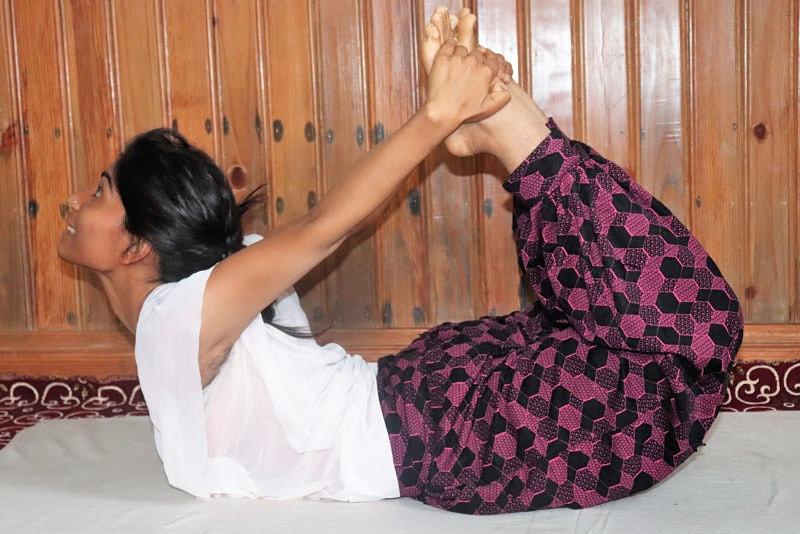
Trikonasana
Trikonasana resembles a triangle. For it, stand straight with legs about two feet apart. Inhale and stretch hands sidewise. Exhale and bend right side facing upwards. Hold the pose for 8 to 10 breaths. Release it with inhalation being straight and bent another side as well.
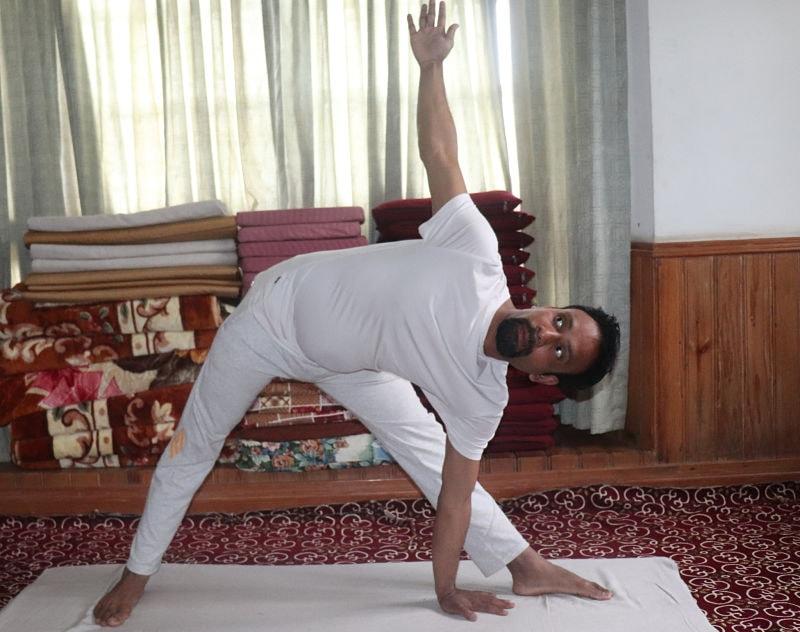
Tadasana
Tadasana means palm tree pose. For this stretch hands upwards with inhalation. Heels should also be lifted up. Try to stretch entire body more and more. Hold the pose for 8 breaths or more. To release, exhale and keep the hands down.
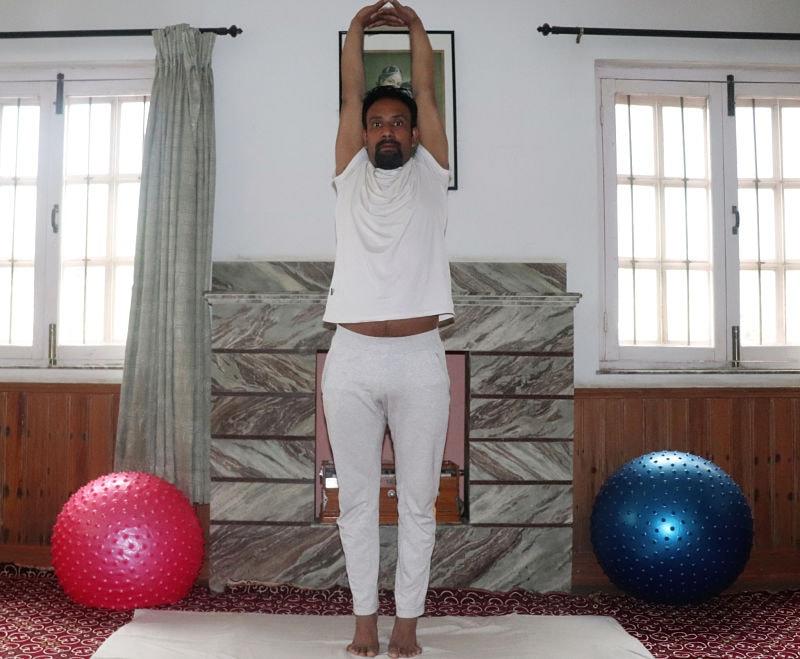
Vrikshasana
This is somewhat similar to Tadasana. One leg is placed on the inner thigh. The heel does not need to raise up. Other steps are similar with Tadasana.
Shashankasana
Shashankasana means hare pose. It has two variations. The steps for the first one are- Sit in Vajrasana. Inhale and raise both hands upwards. With exhalation bend downwards touching the floor with the forehead, hands stretched forwards. Stay in the pose for 8 breaths or more. For the third one- both knees are stretched wide, other steps are similar to the first.
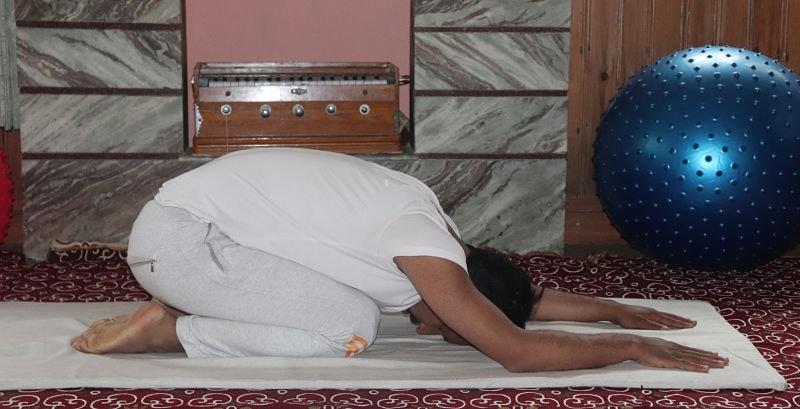
Ustrasana
It is a camel pose. For this, kneel down keeping the body straight. Inhale and raise both hands upwards. Exhale and bend back, place palms on the heel. Hold the pose for 8 breaths or more. To release, inhale and make the body straight.
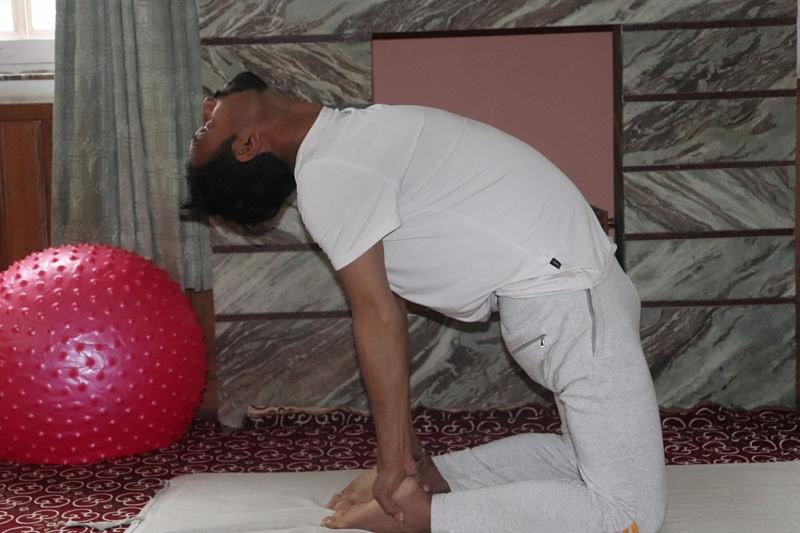
Halasana
Halasana means a plough pose. Lie down on supine. Inhale. Exhale and move the leg upwards and slowly bend towards the ground. Try not to bend the knees. Hold the pose for 10 breaths or more. To release, lie down back to supine.

Bhujangasana
It is a serpent pose. For this- Lie on the abdomen. Inhale. Exhale and lift up chest and head with the help of the hands. The hands should be straight, fixed on the ground beside the waist. Keep bending backward. Hold the pose for 8 breaths or more. Release it with inhalation.
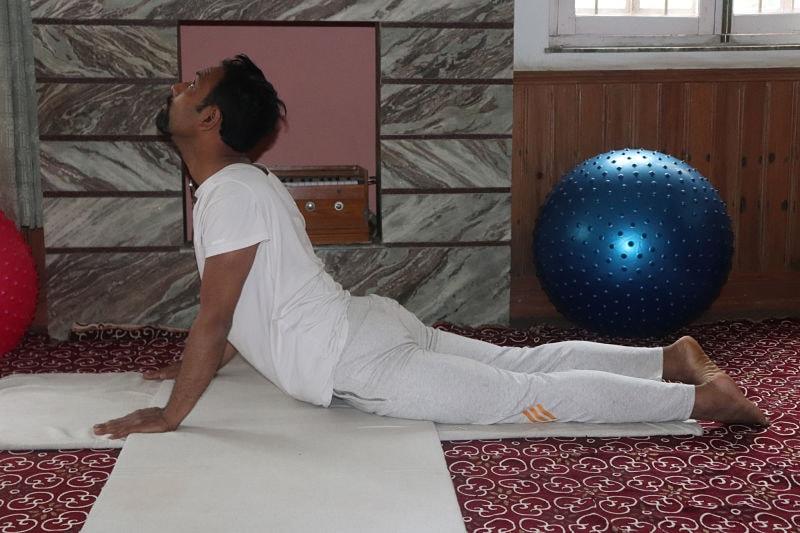
Pavanmuktasana
For this pose lie on the supine. Inhale. Exhale and bring a knee towards chest with the help of hands. Lift up the head as well. Try to bring forehead and knees closer. Hold the pose for about 8 breaths. Repeat the same process with another leg. At last, perform it with both legs.
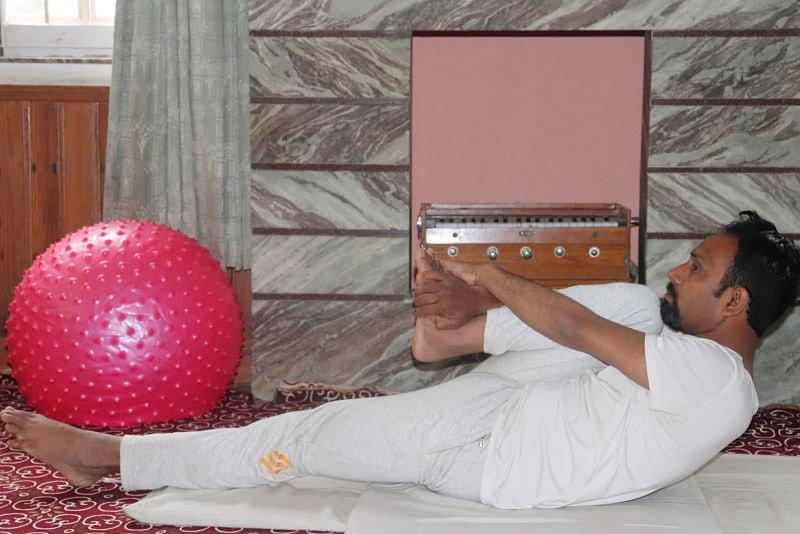
Chakrasana
Lie on the supine. Fix the palms at the sides of the neck, just above the shoulder. Bend the legs and fix the feet near to buttock. Inhale and try to lift the body up with the help of feet and hands. The body becomes like a round wheel. Try to bring hands and legs as close as possible. Hold the pose for 8 breaths or more. To release, lie down on the ground.
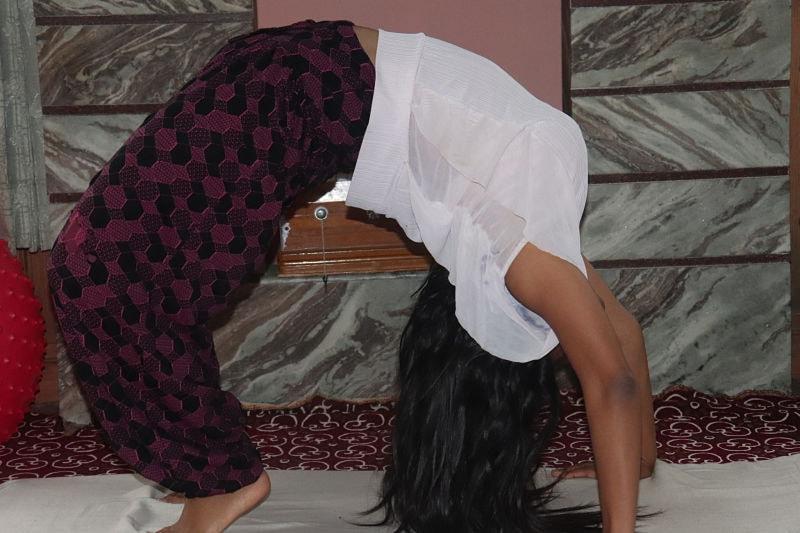
Note: For each pose, one should better observe the inhalation and exhalation. Besides, the practitioner should be conscious in their own body. This consciousness helps him to correct the alignment and feel the sensation of the body. Asana with consciousness gives maximum benefits.
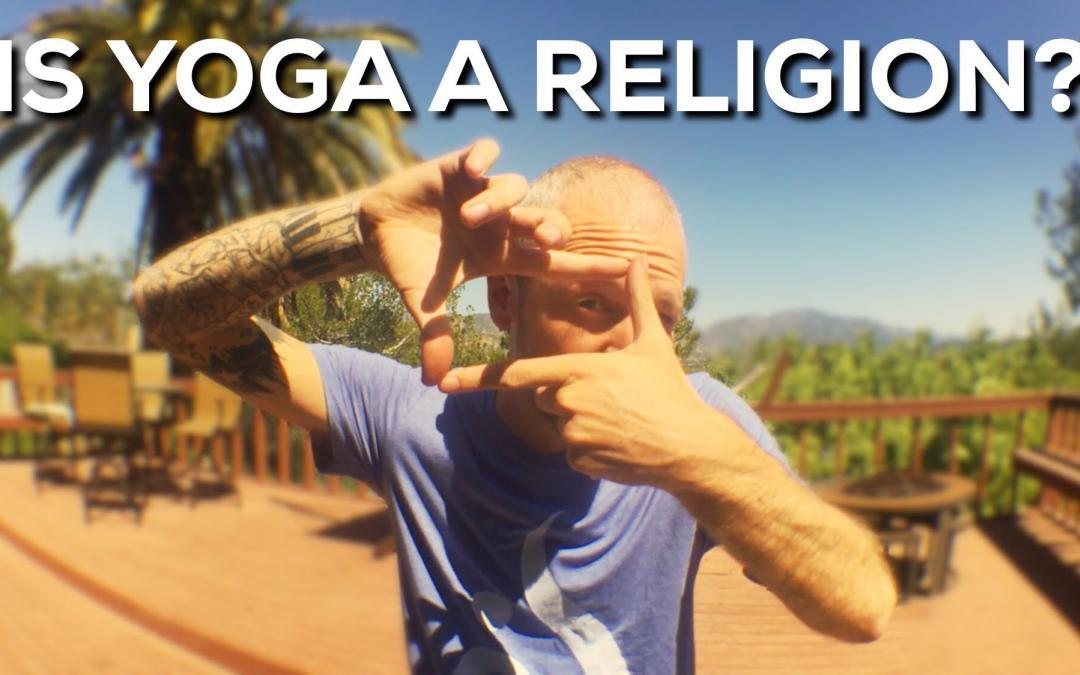
by Tirtha Acharya | Apr 11, 2018 | Yoga
Yoga is not a religion. It is a kind of philosophy that began in Asia estimated 5,000 years ago. The father of classical yoga is Patanjali. Patanjali wrote the Yoga Sutra. Yoga Sutra scriptures provide a framework for spiritual growth and mastery over the physical and mental body. It sometimes interweaves other philosophies such as Hinduism or Buddhism. Most noteworthy is that it is not necessary to study religions in order to practice or study yoga. It is also not mandatory to surrender your own religious beliefs so that you can practice yoga.
What is Religion?
Religion is the belief of a God and worshiping or praying to this God in some sort. In Yoga, there is no God, worshiping or temple, so it cannot really be a religion. As well, Yoga is universal and it is practiced in and by many religious groups. If yoga was a religion itself this would not be possible. In addition yo that just one group would practice it. All religions around the world practice yoga. Hindus, Buddhists, Christians, Catholics, and pretty much everyone practice yoga.There is no definite guide to say who can and cannot practice Yoga. The main focus of yoga is self-improvement, not religion.
In any religion, there is a system of beliefs, which are taught since a very young age. Anyone that grows up in a religious home will remember going to pray or worship. Religious beliefs and values is taught in the home. In Yoga, there are values, but these come from within. They are not taught at a young age by parents or teachers. If you look at parts of the Yoga Sutra it includes non-violence, truthfulness, non-stealing, and fidelity. Most noteworthy is that it is also just part of being a good human being.
Why is yoga not a Religion?
Yoga has no deity to worship.
Yoga has no worship services to attend.
It has no rituals to perform.
Yoga has no sacred icons.
Yoga has no creed or formal statement of religious belief.
It has no requirement for a confession of faith.
Yoga has no ordained clergy or priests to lead religious services.
Yoga has no institutional structure, leader or group of overseers.
It has no membership procedure.
Yoga has no congregation of members or followers.
Yoga has no system of temples or churches.
First of all it will be helpful to consider the difference between the word “religion” and “spirituality.” Spirituality has to do with one’s interior life and one’s self and one’s place in the universe. It is seen as spirituality’s external counterpart. The fact that many yogis report spiritual experiences is amazing. However, it indicates how we might best view the ancient art. In addition to that most of the Westerners practice yoga mainly for health benefits. They only see yoga as a spiritual practice. But, without credos, yoga can’t properly be regarded as a religion. In order to say yoga as a religion, people who practice yoga should have their own religion
Yoga is a Spiritual Experience, not a Religion
Yoga classes vary based on the location of yoga studios. While some yoga studios feature the chanting of Hindu sutras, others will make vaguer references to a “life force” or “cosmic energy”. A session also might end with a greeting of “namaste” and a gesture of prayer. There will probably be a moment for meditation in yoga, where participants may have to repeat the sacred word “Om”. Buddhists and Hindus regard “Om” as a scared sound which brought the universe into being. In addition to that other classes may make no overt reference to spirituality at all.
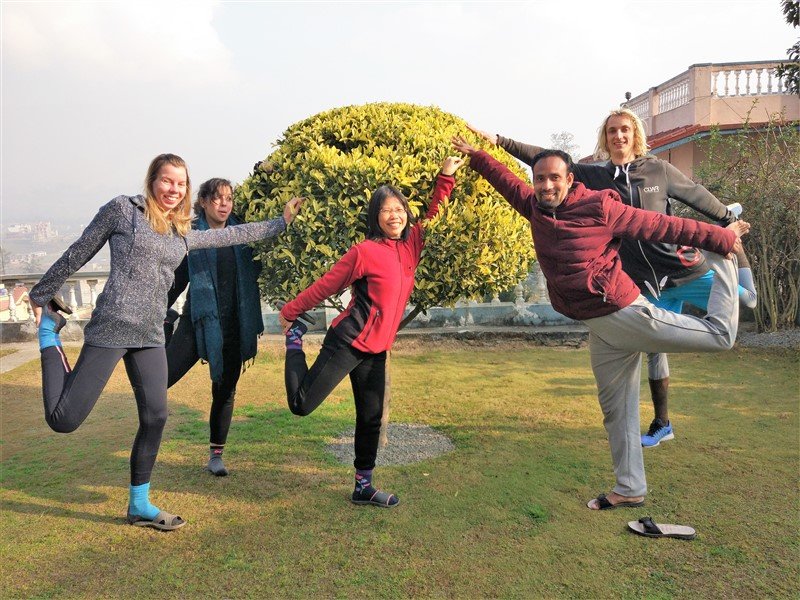
In the west, classes tend to be slower. They discuss much the physical benefits of each position in yoga. In addition to that, yoga competitions are also held which are judged by invited international teachers. Nepal Yoga Home is a yoga retreat in Nepal where you can get yoga training in Nepal and yoga teacher training in Nepal.


















